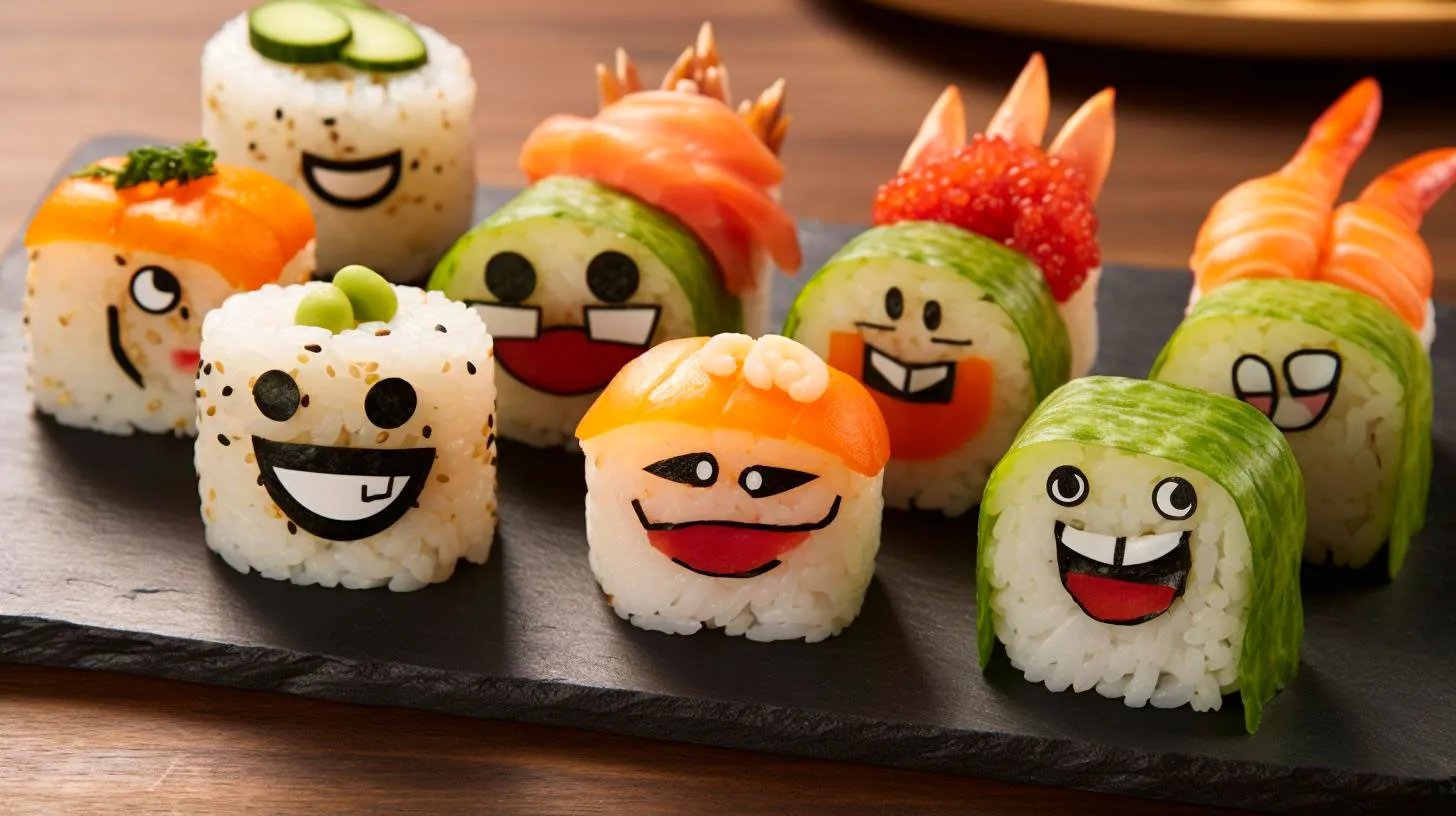From Classic Rolls to Modern Creations: Unveiling the Evolution of Sushi
In this article, we’ll take a captivating journey through the evolution of sushi, exploring its traditional roots and the exciting innovations that have transformed it into a global phenomenon.
The Ancient Origins of Sushi
Sushi traces its roots back to ancient Japan, where it emerged as a way to preserve fish by fermenting it with rice and salt. Known as narezushi, this early form of sushi was a staple for fishermen who needed to store their catch for long periods. Over time, narezushi evolved into the more recognizable style we know today.
Key Takeaway: The ancient form of sushi, narezushi, was used primarily as a preservation technique for fish.
The Introduction of Vinegar
In the 18th century, a pivotal innovation transformed sushi. Hanaya Yohei, a sushi chef, realized that adding vinegar to the rice used in sushi not only preserved the fish but enhanced the flavor. This breakthrough gave birth to a new style of sushi known as haya-zushi, which became immensely popular in Edo (now Tokyo).
Key Takeaway: The addition of vinegar to sushi rice revolutionized its taste and paved the way for further innovations.
The Rise of Edomae Sushi
During the 19th century, Edo (Tokyo) experienced a thriving seafood market, which led to the development of Edomae sushi. Sushi chefs in Edo began using freshly caught fish from Tokyo Bay, showcasing their skillful technique in preparing nigiri sushi. This new style, highlighting simple yet sophisticated flavors, eventually gained recognition across Japan.
Key Takeaway: Edomae sushi focused on using the freshest local ingredients, particularly fish from Tokyo Bay, to create nigiri sushi.
Modern Sushi Innovations
In recent decades, sushi has grown beyond its traditional boundaries, embracing new ingredients, techniques, and presentation styles. Sushi chefs have become more experimental, crafting unique rolls and incorporating influences from other cuisines, leading to the birth of modern sushi creations.
Sushi Rolls: A Contemporary Twist
Sushi rolls, or makizushi, have evolved significantly. While traditional rolls like the hosomaki (thin roll) and futomaki (thick roll) remain popular, innovative variations such as the California Roll and Dragon Roll have gained immense popularity worldwide.
- The California Roll, invented in the 1960s, introduced avocado and reversed the placement of seaweed and rice, making it more palatable for Western tastes.
- The Dragon Roll, adorned with avocado slices, eel, and tobiko (flying fish roe), showcases the fusion of flavors.
Key Takeaway: Sushi rolls have become a canvas for creativity, offering endless possibilities for flavor combinations and unique presentations.
Fusion Sushi: Blending Culinary Cultures
Sushi chefs have embraced fusion cuisine, incorporating ingredients and techniques from various culinary traditions. This adventurous approach has given rise to fusion sushi, creating exciting combinations like the Spicy Tuna Roll, which blends traditional Japanese flavors with a kick of spice.
Key Takeaway: Fusion sushi exemplifies the harmonious blending of different culinary cultures, resulting in unique and flavorful creations.
Growing Popularity and Health Benefits
Sushi has witnessed a surge in popularity worldwide. According to recent statistics, the global sushi market is anticipated to reach a value of $22 billion by 2025, with North America being the fastest-growing market for sushi consumption.
- Sushi is a great source of omega-3 fatty acids, which are beneficial for heart health.
- The high protein content in sushi makes it a healthy and satisfying meal option.
- It is a low-calorie food choice, perfect for those watching their weight.
Key Takeaway: Sushi’s growing popularity can be attributed to its unique flavors, health benefits, and its ability to cater to diverse dietary preferences.
Conclusion
Sushi has come a long way from its humble beginnings as a method of preserving fish. Through centuries of innovation and cultural fusion, sushi has transformed into a global culinary sensation. From traditional nigiri to modern rolls bursting with flavors, sushi remains a testament to the harmony of tradition and innovation. So, the next time you savor a piece of sushi, appreciate the rich tapestry of history and flavors that await you.
Perfect Pairings: Exploring the Harmonious Blend of Sushi and Wasabi
The Essence of Sushi
Sushi, a beloved Japanese dish, has conquered the palates of food lovers worldwide. This delicacy typically consists of vinegar-seasoned rice combined with a variety of fillings such as raw or cooked seafood, vegetables, or even tropical fruits. The combination of flavors, textures, and colors makes sushi a true gastronomic masterpiece.
Key takeaways:
- Sushi offers a delectable fusion of flavors and textures.
- It is versatile, with endless variations to suit diverse palates.
- High-quality ingredients and craftsmanship are essential for the perfect sushi roll.
The Fiery Wasabi Kick
Now, let’s turn our attention to wasabi, the green paste often served alongside sushi. Prepared from the roots of the Wasabia japonica plant, wasabi brings a unique level of heat and pungency to every bite. Fun fact: genuine wasabi is hard to come by and is often replaced with a blend of horseradish, mustard, and green food coloring.
Advantages of wasabi:
- It adds an intense heat that complements the flavors of sushi.
- Wasabi has antibacterial properties, making it a natural food preservative.
- The spiciness can help clear sinuses and aid digestion.
The Science behind the Harmony
When sushi and wasabi meet on your tongue, a fascinating chemical reaction occurs. The compound responsible for the heat in wasabi, known as allyl isothiocyanate, stimulates the trigeminal nerve in your mouth. This creates a tingling, almost numbing sensation, intensifying the natural flavors of the sushi.
Interesting facts:
- Wasabi’s spiciness is transient and diminishes quickly.
- When combined with soy sauce, wasabi’s heat is enhanced.
- Traditionally, wasabi is often placed between the fish and the rice to preserve the sushi’s freshness.
Perfect Pairings
Now that we understand the essence of sushi and the fiery kick of wasabi, let’s explore some perfect pairings that elevate this culinary combination to new heights.
Wasabi and Tuna
Tuna, renowned for its rich flavor and buttery texture, stands tall among sushi lovers. Pairing a slice of fresh tuna with just the right amount of wasabi results in a delightful symphony of flavors, where the spiciness of wasabi enhances the natural sweetness of the fish.
Wasabi and Salmon
Salmon, a sushi staple, offers a velvety, melt-in-your-mouth experience. The subtle smokiness of salmon sings in harmony with wasabi’s heat, creating an irresistible fusion of flavors that lingers on the palate.
Wasabi and Eel
Eel, or unagi, brings a unique flavor profile to the sushi table. Its rich, slightly sweet taste finds a perfect companion in the bold spiciness of wasabi. The combination of tender eel and fiery wasabi creates a tantalizing contrast that keeps you coming back for more.
Final Thoughts
Sushi and wasabi share an inseparable bond, creating a culinary symphony of flavors and sensations. The delicate art of sushi-making and the fiery punch of wasabi come together to elevate this Japanese creation to extraordinary levels.
Next time you indulge in sushi, take a moment to appreciate the perfect pairing of sushi and wasabi. Let yourself be enchanted by the unique flavors and the intriguing chemistry that unfolds on your taste buds.
The Art of Sushi: Preserving Tradition Through Innovative Techniques
From the skilled hands of sushi masters to the freshest ingredients carefully selected, here is an exploration of how the art of sushi is preserving its rich tradition through innovative techniques.
Preserving Tradition: Meticulous Craftsmanship
In the world of sushi, tradition is everything. From the way rice is cooked to the precision of knife cuts, sushi chefs are known for their meticulous craftsmanship. This dedication ensures that each piece of sushi retains its authenticity while delivering an exceptional dining experience.
- Handcrafted Perfection: Sushi making is a true art form that involves years of practice and skill. Each roll or nigiri is carefully shaped by hand, ensuring the perfect balance of flavors and textures.
- Master of Knives: The knife used by sushi chefs plays a crucial role in achieving the ideal sushi experience. A sharp, well-maintained knife allows precise cuts, preserving the integrity of the ingredients.
- Precision in Rice: The rice used in sushi should be cooked to perfection, with just the right balance of stickiness and moisture. The skilled hands of sushi chefs ensure the rice is prepared flawlessly, forming the foundation of every sushi creation.
Innovative Techniques: The Intersection of Tradition and Modernity
While tradition is at the heart of sushi, innovation has become a key element in preserving its cultural significance. Sushi chefs continue to explore innovative techniques to elevate the dining experience and cater to the evolving tastes of today’s sushi enthusiasts.
- Eclectic Ingredients: While traditional sushi ingredients such as fresh fish and seafood are still highly valued, chefs are incorporating a range of eclectic ingredients to create unique flavor profiles. This includes a fusion of ingredients from different cuisines, providing a delightful surprise to sushi connoisseurs.
- Reimagining Presentation: Innovation in sushi extends beyond taste. Chefs are now exploring new ways to present sushi, integrating artistic elements into every plate. These visually appealing presentations elevate the overall dining experience, enhancing both taste and aesthetics.
- Technology at Play: With the advancement of technology, sushi chefs now have access to tools and equipment that enhance their craft. From automated rice cookers that ensure consistent rice quality to precision slicing machines, technology has become a valuable asset in maintaining the tradition of sushi.
Key Takeaways: Balancing Tradition and Modernity
The art of sushi is a delicate balance of tradition and modernity. While preserving the traditional techniques is vital, embracing innovation is equally important to keep up with changing culinary trends and tastes.
By combining the precision and craftsmanship of sushi masters with innovative techniques, the art of sushi continues to captivate food enthusiasts worldwide. From hand-rolled perfection to visually stunning presentations, sushi offers a sensory experience like no other.
So the next time you savor a piece of sushi, take a moment to appreciate the harmony between tradition and innovation. It is in this delicate balance that the art of sushi thrives, preserving its rich cultural heritage for generations to come.
Wasabi: A Touch of Heat and Flavor Elevating Sushi to New Heights
But what exactly is wasabi, and why does it play such a crucial role in enhancing the sushi experience?
What is Wasabi?
Wasabi, scientifically known as Wasabia japonica, belongs to the Brassicaceae family, which also includes horseradish and mustard. Also referred to as Japanese horseradish, wasabi is native to Japan and is primarily cultivated in cool, mountainous regions. It is highly valued for its strong, spicy, and refreshing flavor, which adds a unique zing to sushi dishes.
However, despite its reputation, true wasabi is a rarity. Most of the wasabi we encounter in sushi restaurants is actually a mixture of horseradish, mustard, and food coloring. True wasabi is difficult to cultivate and can be quite expensive, making it a luxury reserved for only the most high-end establishments.
Wasabi: A Sushi Lover’s Best Friend
Now that we know what wasabi is, let’s explore why it has become an essential companion to sushi.
- Enhanced flavor: The pungent heat of wasabi intensifies the delicate flavors of raw fish, enhancing the overall taste experience. Its powerful aroma adds a refreshing element to the sushi, cleansing the palate and making each bite more enjoyable.
- Anti-bacterial properties: Wasabi contains compounds that possess antimicrobial properties, helping to keep raw fish safe to consume. This is especially crucial when it comes to sushi, as consuming the raw fish carries some inherent risks. A touch of wasabi helps mitigate these risks.
- Digestive aid: Wasabi is believed to aid digestion due to its stimulating properties. It can help break down fatty foods and improve digestion, making it an ideal accompaniment to a sushi feast.
- Health benefits: Wasabi is packed with essential nutrients, including vitamins C and B6, potassium, and dietary fiber. These nutrients contribute to overall well-being and can provide a boost to the immune system.
Using Wasabi Correctly
While wasabi adds a burst of flavor and heat to sushi, it is important to use it judiciously.
Follow these tips to make the most of your wasabi:
- Don’t mix wasabi with soy sauce: In traditional Japanese sushi etiquette, it is considered impolite to mix wasabi with soy sauce. Instead, dab a small amount of wasabi directly onto each sushi piece before dipping it in soy sauce.
- Enjoy it in moderation: Wasabi’s fiery kick can be overpowering if used excessively. Start with a small amount and gradually add more if desired. Remember, it is meant to complement the flavors rather than overshadow them.
- Quality matters: Whenever possible, opt for sushi establishments that use authentic wasabi. Although it might be costlier, the experience of true wasabi can elevate your sushi indulgence to new heights.
In Closing
Wasabi is undoubtedly an integral part of the sushi experience. Its distinct flavor and accompanying benefits make it a must-have condiment on any sushi lover’s plate. Whether you are a fan of the pungent heat or enjoy the refreshing aftertaste, wasabi elevates sushi to new heights. So, the next time you indulge in this delectable Japanese delicacy, don’t forget to savor the magic of wasabi!
Do you enjoy wasabi with your sushi? Let us know your thoughts and experiences in the comments below!


